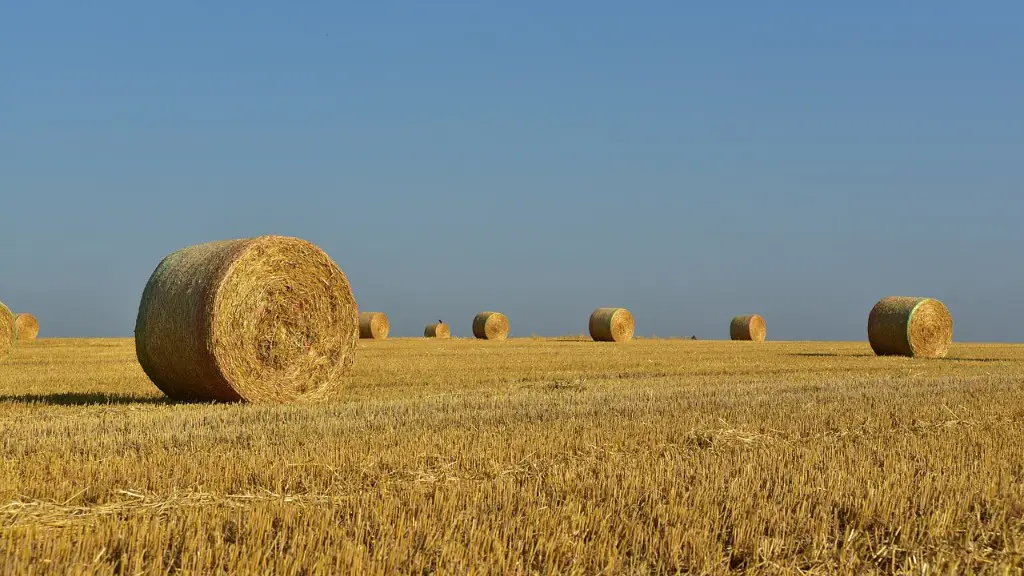Agricultural activities are an important source of greenhouse gas emissions. These emissions come from livestock, such as cattle and other large mammals, and their by-products, as well as from fertilizer application and soil management. Livestock are large sources of greenhouse gases, primarily through methane production when they are digesting food. Fertilizers contain nitrogen, which when released into the atmosphere, is converted into nitrous oxide, a powerful greenhouse gas. Additionally, soil management can result in the emission of carbon dioxide, nitrous oxide, and methane. While these activities make up a small percentage of total global emissions, they still can make significant contributions to the greenhouse gas burden.
Agricultural Practices
Agricultural practices can increase or reduce the emissions associated with them. In order for emissions to be reduced, farmers need to adopt practices that aim to reduce emissions from their specific areas. This includes reducing emissions from fertilizer application, which should be managed carefully to prevent runoff into nearby waterways and other bodies of water. Improving soil quality can also reduce emissions, as healthier soils can decrease the amount of carbon dioxide released from the soil. Additionally, manure management should be well-managed to ensure that the methane emissions released into the atmosphere are limited.
Reducing land use for agriculture by introducing more efficient farming techniques can also help limit the emissions associated with activities such as tilling and land clearing. Also, rotational grazing methods and optimized stocking levels can help minimize methane emissions from livestock. Finally, using cover crops can help absorb carbon dioxide and reduce the need for fertilizer, which can yield considerable reductions in emissions.
The Impact of Global Warming
Global warming is a major environmental and climate concern due to the rise in temperature associated with it. As temperatures increase, it can have a negative impact on crop yields and livestock production, resulting in a decrease in food production which could have food security concerns. Additionally, with higher temperatures comes an increase in precipitation, which can have negative effects on soil quality and fertility.
Along with higher temperatures, there can be increased variability in weather patterns and events, with more droughts and floods. These can be detrimental to agricultural production and can lead to decreased yields as well as damage to crops and livestock. With higher temperatures, increased pest and disease occurrences could also affect agricultural production, leading to a decrease in yields. All of these impacts can have adverse effects on food security.
Technical Solutions
There are a number of agricultural technologies that can help reduce emissions associated with the production of crops and the management of livestock. For example, precision farming technologies, such as automated irrigation systems, can reduce water use and help optimize yields. Additionally, agricultural biotechnology can be used to modify crop and livestock species to increase yields and reduce susceptibility to disease.
New data and analytics technologies can help farmers optimize inputs, such as fertilizer and pesticides, to maximize yields and reduce emissions, as well as increase efficiency in production and consumption. Additionally, farmers can adopt new methods such as cover cropping and rotational grazing to reduce emissions while improving soil fertility.
Role of Policy and Incentives
Government policies and incentives play an important role in encouraging farmers to adopt new technologies and practices that reduce emissions and increase yields. Governments can provide financial incentives to farmers to adopt new technologies, such as precision farming tools and agricultural biotechnology. Additionally, governments can create and implement standards and regulations to reduce or eliminate certain agricultural activities that are known to generate high levels of emissions.
Incentives can be used to promote the use of renewable energy sources, as well as subsidize renewable energy research and development. Additionally, incentives can be used to encourage farmers to reduce their reliance on synthetic fertilizers and adopt more sustainable methods of soil management. Furthermore, governments can provide support for research and development of improved soil management practices that could significantly reduce emissions.
Changes in Consumption Patterns
Finally, changes in consumer behavior can have a positive impact on emissions associated with the agricultural sector. By reducing meat consumption and instead opting for more plant-based sources of protein, emissions associated with the livestock sector could be considerably reduced. Additionally, consumers can opt for more sustainable and locally produced food options, reducing the amount of energy needed for transporting products over long distances.
In addition, consumers can reduce their food waste by properly storing food, using leftovers and composting scraps. This can significantly reduce the amount of food waste, something that can considerably decrease emissions associated with the production and transportation of food.
Green Purchasing Options
Consumers can also opt for green purchasing options, such as organic and fair trade products. Organically grown produce is grown without the use of synthetic pesticides and fertilizers, resulting in higher nutrient content and lower emissions associated with their production. Fair trade products are produced in compliance with certain ethical and labor standards and thus have a smaller carbon footprint than other options.
Consumers can also opt for products that have been certified to have reduced emissions during their production and distribution. This includes products that are certified under the Carbon Trust and Climate Neutral labels. Additionally, when consumers purchase from local producers, they are helping to reduce the emissions associated with transporting products from distant locations.
Alternative Fuel Production
Using agricultural feedstocks to produce alternative fuels is another potential to reduce emissions. These feedstocks can be used to create biofuels, such as biodiesel and ethanol, which can replace conventional fuels in many applications. While this can reduce emissions, there is a risk of land and water use degradation associated with this type of production. Additionally, there are concerns that increased demand for feedstocks may drive up the cost of other food commodities, such as corn or soybeans.
Agricultural activities are an important source of greenhouse gas emissions and it is important to reduce these emissions to reduce the impacts of climate change. The adoption of new technologies, changes in consumer behavior, and the implementation of government policies can all contribute to reduce emissions associated with the agricultural sector. Additionally, there are options for producing alternative fuels from agricultural feedstocks, although these must be implemented carefully to avoid unwanted side effects.



